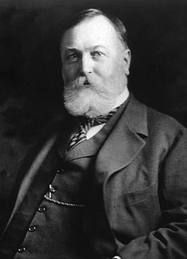Clarence W. Barron facts for kids
Quick facts for kids
Clarence W. Barron
|
|
|---|---|
 |
|
| Born | July 2, 1855 Boston, Massachusetts, U.S.
|
| Died | October 2, 1928 (aged 73) |
| Occupation | Financial journalist |
| Spouse(s) | Jessie M. Waldron |
| Children | 2 adopted daughters (Jane & Martha) |
Clarence W. Barron (born July 2, 1855, in Boston, Massachusetts – died October 2, 1928) was a very important person in the history of Dow Jones & Company. He was a dedicated newsman who became the president of Dow Jones. He also managed The Wall Street Journal. Many people see him as the person who started modern financial journalism.
Contents
Early Life
Clarence Barron went to Boston English high school. He finished school in 1873.
What He Did
Clarence Barron worked for many newspapers during his life. These included the Boston Daily News and the Boston Evening Transcript. He worked at the Transcript from 1875 to 1887.
In 1887, he started the Boston News Bureau. Later, in 1897, he started the Philadelphia News Bureau. These bureaus gave financial news to people who bought and sold stocks.
Taking Over Dow Jones
In March 1903, Barron bought Dow Jones & Company for $130,000. He bought it after one of its founders, Charles Dow, passed away. In 1912, he made himself president. This job allowed him to control The Wall Street Journal.
He made his news bureaus part of Dow Jones. This helped him make his publishing business bigger. By 1920, he had increased the number of The Wall Street Journal copies sold each day. It went from 7,000 to 18,750. By 1930, it was over 50,000 copies. He also worked hard to make the newspaper more modern. He brought in new printing presses and hired more reporters.
Starting New Publications
Barron also started a company called Doremus & Co. in 1903. This company helped businesses advertise their financial services.
In 1921, he started a new financial magazine called Barron's National Financial Weekly. It was later renamed Barron's Magazine. He was its first editor. He sold the magazine for only 10 cents a copy. By 1926, it was selling 30,000 copies. It became very popular with investors and financial experts.
His Family
Clarence Barron married Jessie M. Waldron in 1900. He adopted her two daughters, Jane and Martha. Mrs. Barron passed away in 1918.
Jane Barron married Hugh Bancroft in 1907. She became an important member of the Boston Brahmin Bancroft family. Martha Barron married H. Wendell Endicott, who was set to inherit the Endicott Shoe Company. Mr. and Mrs. Barron, along with the Endicotts, are buried together. Their grave is at the historic Forest Hills Cemetery in Boston.
What He Left Behind
After Clarence Barron died, his son-in-law Hugh Bancroft became president of Dow Jones. His friend Kenneth C. Hogate became the managing editor of the Journal.
Two books, They Told Barron (1930) and More They Told Barron (1931), were published. These books showed how close he was to important financial leaders in New York City. People like Charles M. Schwab trusted him. Because of this, he was called "the diarist of the American Dream."
Fighting for Truth in Journalism
Some people thought he was too close to the people he wrote about. However, Barron was known for pushing for careful checks of company financial records. This is why he is seen as the founder of modern financial journalism.
Barron believed The Wall Street Journal should always stand for what is best in Wall Street. For example, in 1913, he spoke to the Massachusetts Public Service Commission. He talked about a secret fund held by the New Haven Railroad.
In 1920, he investigated Charles Ponzi for The Boston Post. Ponzi was the inventor of the Ponzi scheme, a type of financial fraud. Barron's strong questions and common sense helped lead to Ponzi's arrest and conviction.
The Bancroft family owned most of Dow Jones until July 31, 2007. That's when Rupert Murdoch's News Corp. bought enough shares to take control.
Fun Facts
- He helped give two million dollars to the Clarke School for the Deaf. He suggested naming it the Coolidge Trust after President Calvin Coolidge and his wife Grace.
- Clarence W. Barron's old mansion in Boston is at 334 Beacon Street. It is right next to the Charles River. In the 1980s, the building was turned into apartments. Since 2007, a picture of Clarence W. Barron has been on display in the main room of the old mansion.
Books He Wrote
- The Boston Stock Exchange (1893)
- The Federal Reserve Act (1914)
- The Audacious War (1915)
- The Mexican Problem (1917)
- War Finance (1919)
- A World Remaking; or, Peace Finance (1920)
- Lord's Money (1922)
- My Creed (unknown year)
See also
- William Peter Hamilton

